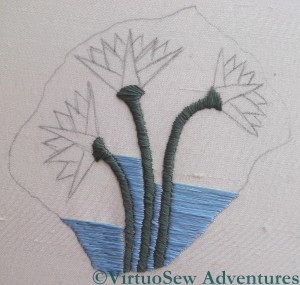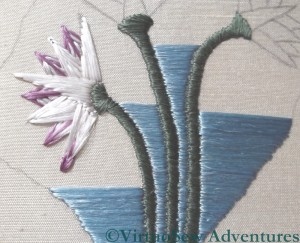Developing confidence in satin stitch
It may not seem as though much has been going on with the Lotus Fragment, apart from satin stitch, but I have in fact been learning a lot, and experimenting rather a lot too.
To begin with, I was intending to use a couching stitch for the blue background of the image. This is partly because I keep forgetting that the final Dreams of Amarna panels are not intended to be worn or leaned upon. The stitches would need to be quite long, which is contrary to my ingrained instinct to keep stitches short in order to make the finished article reasonably hard-wearing. But then, stitched on silk, using silk, it was never going to land in the washing machine!
After my short class with Midori Matsushima, I had a little more confidence in my satin stitch, and so I worked one side of the fragment in satin stitch and the other in Bokhara Couching, and then sat back and looked at them. Satin Stitch won, hands down. The flat silk spreads beautifully to help blend the stitches, and the reflectance of the silk filaments creates an almost radiant effect. So that small section of couching has been unpicked, and replaced in short order! In fact, the satin stitch fairly galloped away once I got settled and gained some facility with my mellor.
The lotus flowers themselves are giving me a little more trouble. As you can see in the second photograph, I have been trying various ways of stitching them. My challenge is that Mary Chubb describes the originals as “faintly lilac-tipped”, and so my experiments have two goals, not just one: I want to find the most effective way to use the silk to represent the lotus flowers, but at the same time it has to be a way that lets me tip the petals in the lilac without creating a clumsy effect.
The earlier petals use stitches that come to a point at the tips of the petals, crossing under a central stitch that seeks to smooth those tips. I am not happy with this – it looks clumsy and heavy, even though it makes adding in the lilac stitches fairly easy.
The later stitches use a more classical satin stitch, with the longest stitch on one long side of the petal, and shortening stitches creating the other side. This is better, and I think will be improved if I take all of the experiments out and then begin again, with the long stitch on the central axis of the petal and shorter ones to the side.
However, the challenge of creating the effect of the lilac tips remains. I want to blend the lilac and white stitches into one another, and for the life of me I can’t see how to achieve it, or even whether to stitch the lilac first or the white!



I love your satin stitched silk. It looks so rich and deep. I have an absolute dread of satin stitch. It has been lessened slightly by the classes I took in white work with Jenny Adin-Christie from the Royal School of Needlework, but it is still a dread.
I have done Japanese embroidery for years and I have two suggestions. First, I would elongate your points. I agree the petals are looking a bit clunky, and going one point beyond your flower tip will hopefully help give it length. Also, I would start with the lilac right at your tip, stitch a couple of long stitches and then start your white. Then you can control how much lilac is visible with the white. I guess a third suggestion would be to consider some subtle form of couching in your water. Stitches over 1 cm can get messy very easily and JE has a couple of ways of holding in a very subtle fashion that would protect the tread over time but retain your look. I know there are a number if JE practitioners in the UK; maybe someone close to you might be willing to give you another short demo. It is looking lovely, and it will be fun to see what you come up with. Good luck!
The satin stitch is looking lovely, I much prefer it to the couching in this instance. I’m not sure what size your piece is, it is difficult to tell from a photograph. As Kris said, in JE we usually do some form of holding on any stitches longer than 1 cm. However, since your panel will not be worn or leant up, and as I suspect your stitches are only slightly longer than 1cm, I would not use any holding stitches here. I think Kris has offered some good advice for the lotus flowers, especially working the lilac tips first, then working the white into the lilac, almost like a long and short stitch. Also, if you are doing them in flat silk, which I think you are, you could split the strands then combine half of white with half of lilac (or more or less of each colour) to give a more subtle tip.
If you would like a longer explanation of any of the techniques Kris mentioned, you have my email. I would be happy to elaborate.
Oh, that stitch looks gorgeous!
Oh, this is lovely — I absolutely love your beautiful satin stitch (I’m afraid my hands could never be so precise) and the colors are so soft and lovely. I often have the feeling, when looking at your work from afar, that you understand the thread deeply. You know, almost instinctively it seems, what stitch works best to show off what threads.
i can achieve a fairly decent satin stitch if i first do an outline stitch, but have never done a satin stitch with such long stitches. you are doing a beautiful job, in my opinion. maybe putting a thread of both lilac and white in the needle and stitching both at the same time would combine the color some. a variegated thread would do it, but looks like you are using a specialty thread here. your work is beautiful.
It looks quite beautiful, but you do set yourself some challenges! I see you have good advice above from those in the know, so hopefully you can make some progress. Blogging is great for sharing knowledge and the benefit of experience that you just couldn’t get elsewhere, isn’t it. Look forward to the next installment. Cathy
The satin stitch with the Japanese flat silk is perfect for the job – the way the light reflects from it is stunning. Perhaps it’s heresy, but one thing that occurred to me about the lilac tips of the petals would be to use white and then a silk paint or pen like Setascrib to tint the tips in the right place. Just a thought.
Looks challenging and different from the transitional stitches. I need to read more and learn from you. Your work is inspiring.
I was going to suggest splitting suga of purple and white for the tips, but Carol-Anne already has, and Kris’ advice about putting the purple down first to control how much appears sounds really good – I’ll remember that.
Satin stitch is so tricky and I never use it as I can’t seem to get it right…unlike you! It’s perfect Rachel.
[…] week I posted about my progress on the Lotus Tile Fragment, and commented that I was rather concerned about producing a suitable effect. Remember, the […]